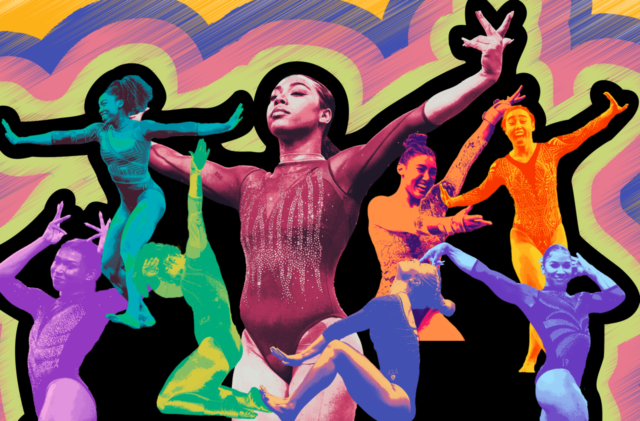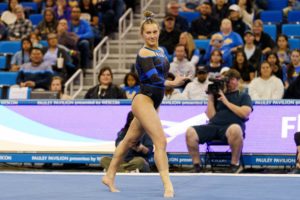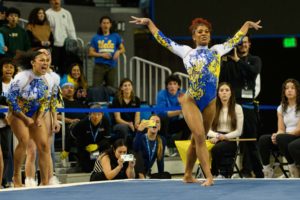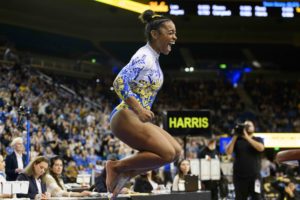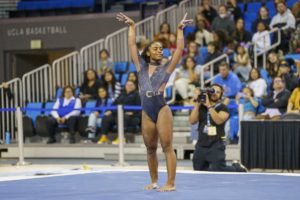Yates Gym holds its breath in anticipation when music hits the air.
Gymnasts stop twirling on bars and come to a standstill on beam to watch the Bruins take the floor.
Even when it’s just another preseason practice, and the teammates have seen the routine before, they can’t help but stop, stare, cheer and dance alongside the floor competitors.
Season after season, the world watches to see what the Bruins will do next on the apparatus – evoke laughter, spark joy, start conversations?
Beyond its mark on the record books as a legendary program, UCLA gymnastics’ floor routines – embodying individuality and artistry – have created ripples across gymnastics at every level.
Roster names have become household names, and the Bruins’ floor routines have generated space for the members of their lineup to express themselves beyond their skills.
“Being acknowledged for not just the tumbling I do but for the dances that I do is so progressive,” said senior Chae Campbell. “I love that people are acknowledging the full art of floor because I think that really elevates UCLA gymnastics.”
But UCLA didn’t build its floor legacy overnight. That story began over four decades ago.
As each season goes by, another routine goes viral and more gymnasts transcend sport through tumbling and dance, and perhaps the most renowned NCAA gymnastics tradition takes its rightful spot on center stage.
This is the UCLA gymnastics floor effect.
Culture that transcends a coaching staff
Valorie Kondos Field won seven national championships, was named Pac-12 Gymnastics Coach of the Century and cemented UCLA’s status as a blue blood of gymnastics through her 29-year head coaching tenure.
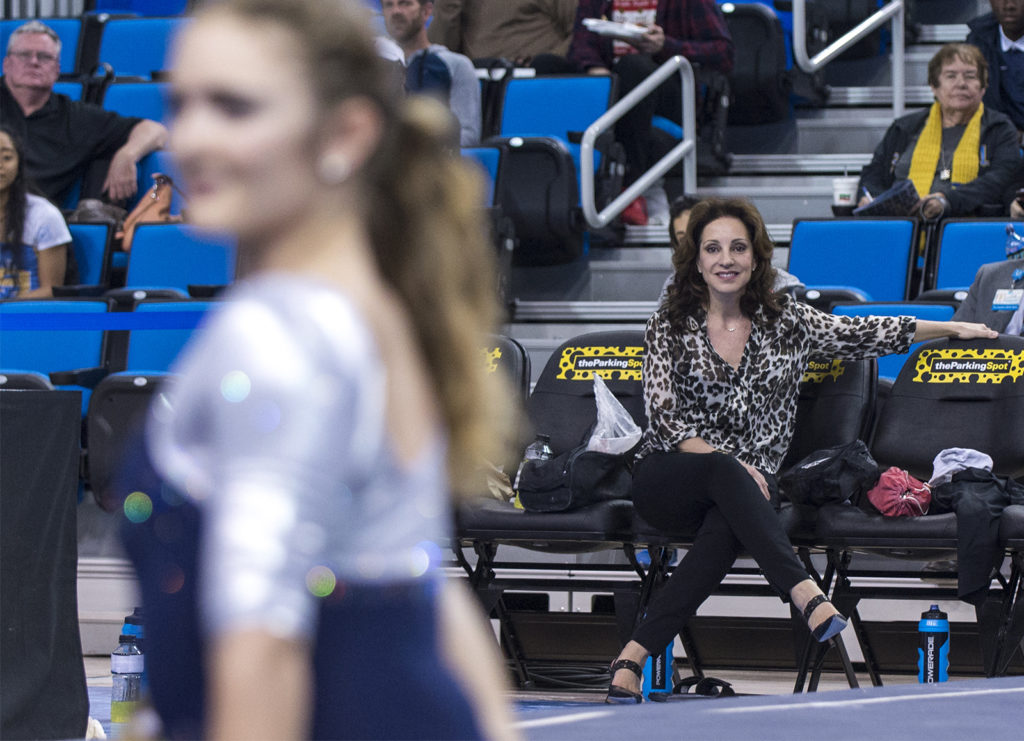
But before any of that was true, Kondos Field made her mark on the program through her dance training.
As the Bruins’ choreographer starting in 1983, Kondos Field shifted floor routines from a traditional tumbling showcase to a cohesive demonstration of artistry – something never before seen in the sport.
[Related: Gymnastics coach Valorie Kondos Field shapes more than just routines]
Taking over in the choreography department following Kondos Field’s retirement more than three decades later in 2019 was now-assistant coach BJ Das, who melds her professional dancing and gymnastics backgrounds as she helps UCLA craft its floor routines.
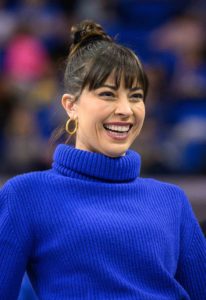
The former Washington gymnast’s choreography and dance resume spans everything from a Kesha music video to the Academy Awards. Before joining the Westwood staff, she had watched the Bruins from afar as UCLA greats Ariana Berlin, Hallie Mossett and others pushed the sport’s boundaries by incorporating dance and pop culture, making Das wonder where this had been when she was a student-athlete.
“It just brought so much joy to the sport,” Das said. “It made me so happy being in both worlds that I was very gravitated towards UCLA and always thought, in terms of floor routines, theirs were the gold standard.”
For the better part of 41 years, UCLA has set the blueprint for collegiate gymnastics floor routines. And yet, try as they might to replicate that formula, other top gymnastics programs don’t hold a candle to UCLA’s national recognition.
“UCLA is definitely setting a standard,” said Pac-12 commentator and UCLA alumnus JaNay Honest, who graduated in 2018.
Das first coached collegiate floor in Utah as its volunteer assistant coach for a year before joining UCLA in 2020.
She said although the Red Rocks consistently produced a top floor program, artistry was never a focus.
“There wasn’t this pride and ownership of floor specifically,” Das said. “It was a program that was very prideful in their gymnastics team, but I didn’t see as much of an emphasis on the performing, and it wasn’t necessarily part of their culture to get really out of their comfort zone.”
But in Westwood, artistry and individuality have earned such buy-in from Bruin gymnasts and staff that it’s become exactly that: a program-defining culture.
“Everyone wants their floor routine to be unique and different, and we would embrace that uniqueness,” said Gracie Kramer, who graduated from UCLA in 2020. “Thank goodness that culture stayed. … It’s what makes UCLA gymnastics such an amazing program.”
Individuality: The greatest constant
Central to UCLA’s floor culture is its emphasis on individuality and self-expression; no routine is the same as the next.
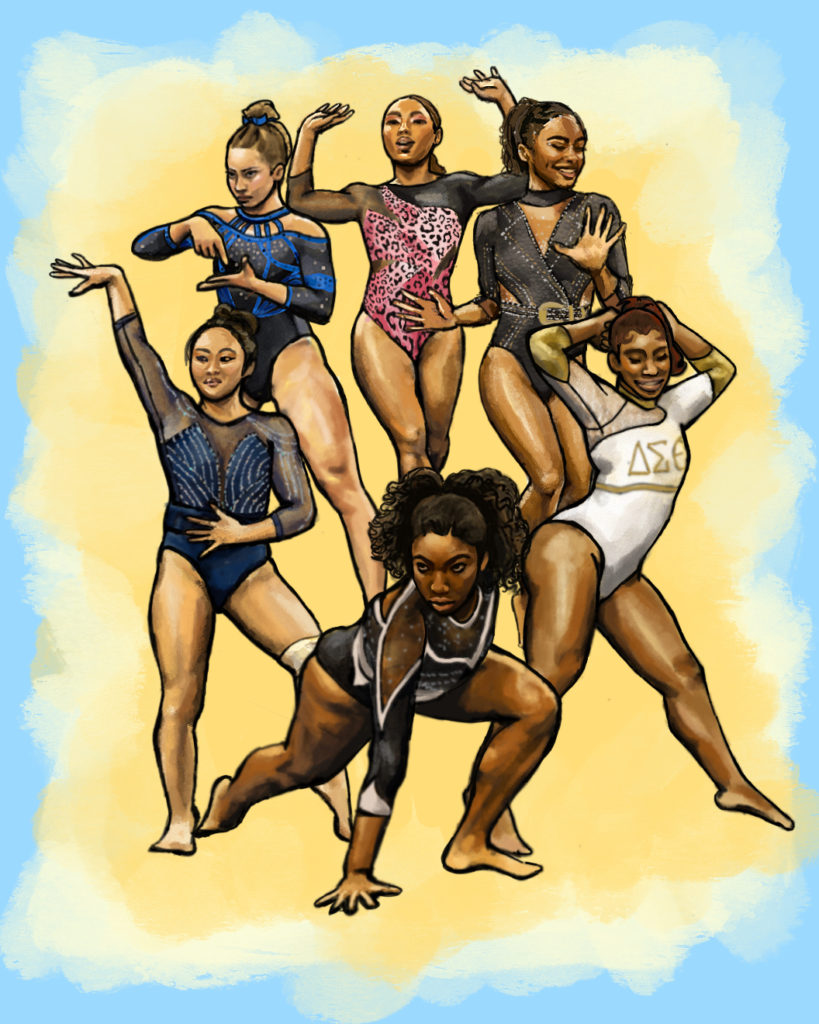
Both Kondos Field and Das have been lauded for their ability to emphasize gymnasts’ strengths and styles.
The result?
A floor lineup akin to a dance party – but you never know if the next number will make you laugh or weep.
“BJ, she’s really good at knowing that everyone doesn’t dance the same, and I think that’s where a lot of people go wrong,” said graduate student Margzetta Frazier. “She’s able to look at all of us and see what we would feel the most confident doing.”
Whereas some choreographers might put together a routine by themselves and teach it, Das involves the Bruins in every part of the choreography process.
First step: soundtrack.
Das and a gymnast build a playlist that they’re interested in bringing to Pauley Pavilion. Sometimes, Das narrows down 85 songs to a maximum of five, but no genre is off limits. Even heavy-metal band Metallica joined the mix in senior Frida Esparza’s 2024 routine because nothing fired her up the same.
[Related: iPhone ringtone transforms UCLA gymnast’s floor routine]
Honest, who performed her fair share of UCLA floor routines before commentating plenty more, knows that feeling firsthand.
“You’re going to perform it at another level when your heart’s in it, and you felt involved, and it’s something that you’re passionate about,” Honest said.
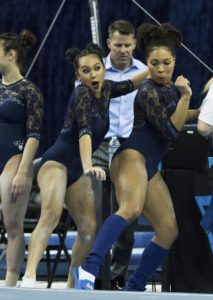
From there, Das mixes the music and freestyles it in the studio to feel the flow of the gymnast and their character, but the most important part comes when the gymnasts join Das in the studio.
As a young dancer, Das quickly realized positive feedback was far more motivating than hypercriticism. She encourages gymnasts to bring their friends into the studio with them, so they can decide which dance styles they feel most comfortable and confident in.
“It’s finding what looks good on somebody, and then encouraging more of that, than trying to mold somebody into something they’re not,” Das said.
Das does not rush the process – even when on a time crunch in the preseason and balancing choreographing multiple routines at once.
She wants the gymnasts to have fun and embrace the choreography process.
Some gymnasts choose to embody their favorite movies, such as Campbell with “Black Panther” or graduate student Chloe Lashbrooke with “Barbie.”
[Related: The Dark Witch of Westwood: Behind Katelyn Rosen’s spellbinding gymnastics routine]
Others embrace music close to their hearts, as Frazier did.
The sixth-year gymnast has toyed with different styles over the years and opted not to include a larger story behind her 2024 routine.
“I wanted the girls to laugh. I want them to be in the corner cracking up,” Frazier said. “It encompasses the music I love and that I love to dance.”
Individualized routines also allow the gymnasts to tackle social issues – as seen by Nia Dennis’ viral 2021 “Black excellence” routine – or embrace their culture, as graduate student Nya Reed did this year.
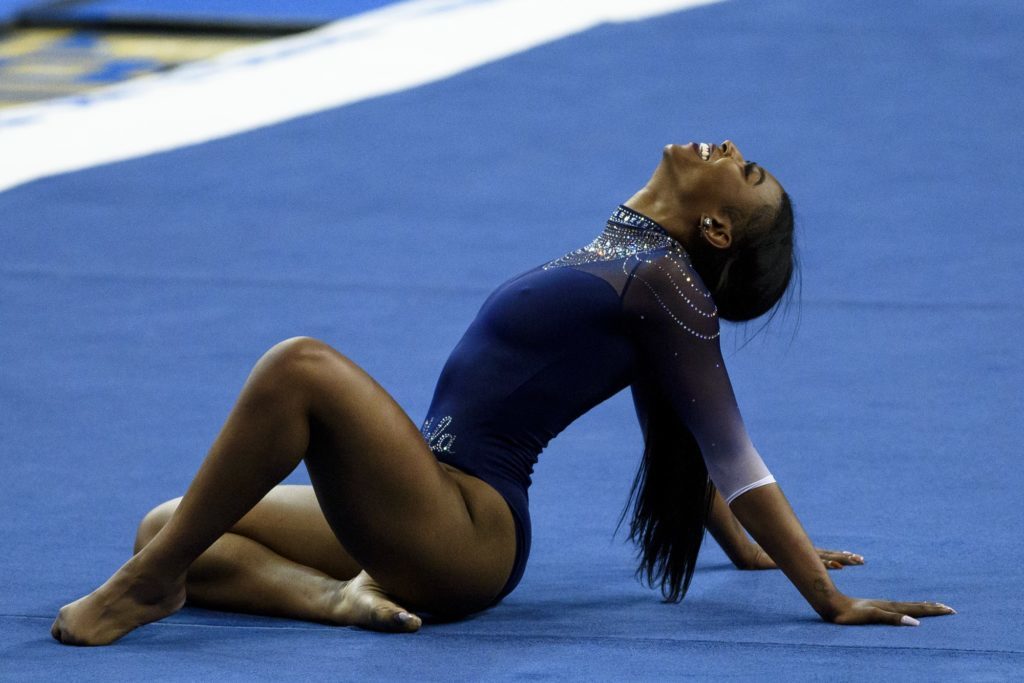
Reed hoped her routine would honor her sorority – Delta Sigma Theta, a National Pan-Hellenic Council’s Black Greek organization – and show who she was without speaking.
“I have a lot of culture in my routine,” Reed said. “I want more HBCUs to have gymnastics. So that was kind of me raising awareness about that.”
The 2024 floor lineup is the Bruins’ most theatrical assembly yet, Frazier said, although few besides her would dare to say UCLA had been playing it safe.
Now in her fifth year coaching the Bruins and second year in a full-time coaching position, Das still continues to grow and push the boundaries of what floor routines could be.
“We’re really ready to go all out,” Frazier said.
Embracing performers from the get-go
UCLA’s floor culture needs no introduction among the gymnastics community.
As such, even if some athletes didn’t consider the competition floor a performance stage while competing in elite or level 10 gymnastics, UCLA ultimately attracts a like-minded group.
Janelle McDonald, in her second year as the Bruins’ head coach, said she embraces UCLA’s floor history during the recruitment process, helping her find gymnasts who mesh well with the program so they can extend its legacy.
“One of the things I love about this program is just the rich tradition and history, and I think our floor parties are absolutely part of our tradition and our culture of our team,” McDonald said.
Although pre-NCAA gymnastics rarely showcase floor routines with the same attitude, Das said the gymnasts’ experience levels don’t pose a challenge. The team – and every recruit – is motivated to push themselves as performers.
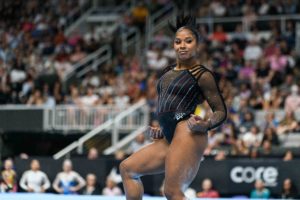
For many potential recruits, UCLA’s floor routines present a huge draw – increasingly so in the era of name, image and likeness.
Take Jordan Chiles, for instance. After winning a silver medal at the 2020 Tokyo Games, she brought her Olympic gymnastics to the Pauley Pavilion floor, earned newfound popularity, won two individual NCAA championships and secured a brand deal with Nike.
[Related: ‘I’m doing it for me’: Jordan Chiles flips script, sets sights on 2024 Olympics]
On a rudimentary level, the Bruins’ floor routines have made a name for themselves with joy and passion so infectious that younger gymnasts dream of joining UCLA.
“The first thing that caught my attention was the floor routines,” said freshman Katelyn Rosen. “I could sit on YouTube and watch those for hours. I always just wanted to be a part of that performance.”
A click on YouTube can inspire it all, and now as a regular member of UCLA’s floor lineup, Rosen has become one of the gymnasts future Bruins will spend hours watching.
The viral formula
Reed woke up missing so many texts and calls, she thought she had slept through a team meeting.
In reality, she’d gone viral.
“I felt like every gymnast wants that routine to go viral and be able to enjoy that moment,” Reed said. “I was very, very excited about that and able to just be a part of that legacy and be able to have one of those routines from UCLA.”
In retrospect, it may have seemed inevitable that Sophina DeJesus, Katelyn Ohashi, Mossett, Dennis, Frazier and Chiles all would appeal to the masses – but any one of the Bruins could go viral.
How does UCLA manage to repeat its viral success season after season, with every routine wildly different from the next?
The question is almost as much of a mystery to Das, who doesn’t consider herself tapped into social media enough for it to be a conscious effort.
“I’ve never made a TikTok in my life,” Das said.
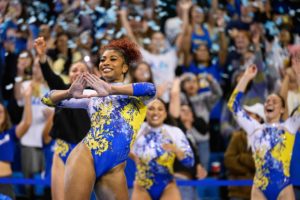
But Honest has seen a few common denominators between the viral routines.
Featuring mainstream artists’ music, as seen by Campbell, Mossett and Dennis’ Beyoncé routines or Frazier with Janet Jackson, helps pique the audience’s interest. It also comes down to timing.
“I think it’s a moment thing,” Honest said. “All of these routines have a potential to go viral.”
Kramer, with her own acclaimed perfect 10 routine, agreed that tapping into pop culture can contribute to a routine’s success online, but she also views artistry as one of the most important aspects of connecting with the audience.
“I just remember being like, ‘I want to be 100% bought into this performance,’” Kramer said. “That’s what the viral recipe was.”
DeJesus claims UCLA’s first truly viral routine, tapping into major pop culture phenomena when she “whipped,” “nae-nae’d” and “hit the quan” in 2016.
[Related: DeJesus’ dance, dab draws spotlight on UCLA gymnastics]
Since then, the Bruins’ standard of virality has changed, keeping pace with social media.
DeJesus’ video reached a staggering 40 million views eight years ago. But subsequent viral routines have reached even greater heights – with Ohashi’s 2019 routine garnering more than 243 million views on YouTube alone.
With expanded viewership and reach came opportunities for gymnasts to capitalize on their moments.
DeJesus appeared on “Ellen,” Ohashi won an ESPY, Dennis attended the Met Gala, Salt-N-Pepa shouted out Chiles and several received coverage from ESPN and the New York Times.
“I remember just hoping that it didn’t get into gymnasts’ heads of like, ‘Oh, I need to go viral, so I can make money,’” Honest said.
But Das said choreographing, to her, is never about the pursuit of clicks and views. To do so would be antithetical to the Bruins’ values; authenticity lies at the heart of UCLA’s floor culture.
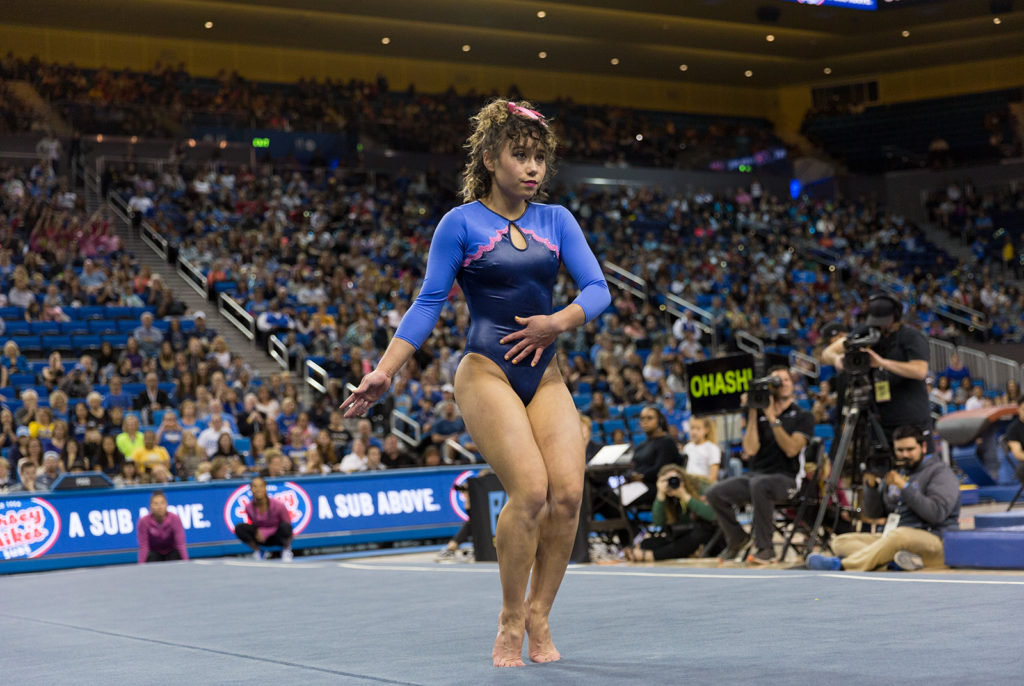
Intentional or otherwise, UCLA gymnastics now has the world’s attention with nearly 1.2 million followers on X, formerly known as Twitter, as well as Facebook and Instagram. In 2020, UCLA had the largest social media following of any collegiate women’s sport.
With increased followers and a ready audience for UCLA, the dynamic inherently changed, as people now expect exceptionalism year after year, Honest said.
Looking for what routine is going to be the next big thing creates a self-fulfilling prophecy for the Bruins.
No passivity in the pursuit of perfection
While UCLA’s commitment to floor is synonymous with the program, its success doesn’t come standing idly by during the offseason.
Intentionality, a word McDonald has repeated since taking over as head coach, defines UCLA’s approach in every aspect – from sticking landings to making eye contact with the audience.
The Bruins’ coaching staff seeks to hone the gymnasts’ artistry and intensity as performers primarily through studio days, when Das teaches the team dance routines.
At first glance, dancing in the gym may seem like a fun activity to elevate gymnasts’ heart rate, but the warmups also build confidence as performers. The added dance elements create a whole new level of difficulty in an already strenuous event.
“It’s the part that requires being present and connecting with people and making eye contact with people in the crowd,” Kramer said. “And then you can just take a deep breath, smile, tumble, and then you’re usually going to knock it out of the park.”
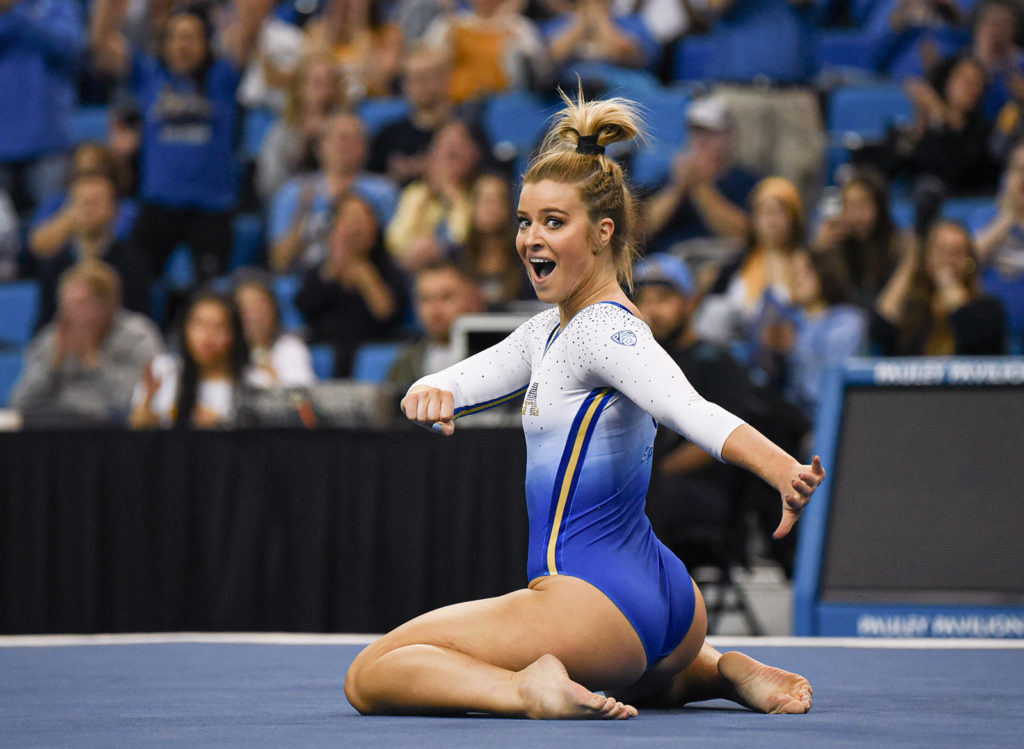
Das’ efforts don’t stop in warmups or preseason choreography. Although it may not warrant a deduction in points, musicality makes or breaks a routine in Das’ eyes.
“I stay on them from the time we learn the routine till season,” Das said. “The routines are so nuanced and choreographed to the music that if they’re off the beat at all, I don’t let it fly.”
On top of being performance perfectionists, the Bruins’ are consistently a top floor program on the scoreboard itself, boasting 58 perfect 10s and 13 individual national titles. Since 2010, UCLA has only finished outside the top 10 in national floor rankings once.
Even when other events aren’t coming together for UCLA, the Bruins’ attention to detail and trust in their preseason work means they can always depend on a floor party to end on a high note – both in spirit and on the scoreboard.
Program-defining legacy
UCLA’s pioneering on floor has created impacts that extend far beyond Westwood.
When routines go viral and gymnasts attend talk shows or interview with national outlets, gymnastics becomes a talking point among entirely new audiences.
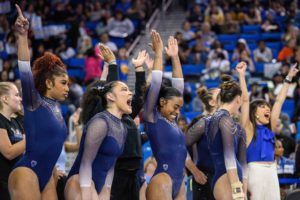
This effect, coupled with increased investment in gymnastics from ABC and ESPN in the last few years, creates valuable visibility for the sport.
And even within gymnastics itself, UCLA has changed the game.
“I’ve seen it across the board and same with elite: really emphasizing artistry,” Das said. “That’s become more prevalent in the last couple years, and I think going into this next Olympic Games, I think you’re going to see a lot more artistry.”
Junior Emma Malabuyo – eyeing a 2024 Paris Olympic berth – has transitioned her UCLA floor routine to elite competition, increasing difficulty while maintaining the music and choreography of her NCAA performance.
Other choreographers and gymnasts have taken notes from the Bruins – including Honest, who brought the lessons about individuality to her work choreographing routines for younger gymnasts.
Trendsetters and head-turners, the Bruins’ greatest constant is their individuality.
It’s the kind of gymnastics that makes you stop what you’re doing, stop scrolling, stop flipping in the middle of practice to appreciate the sport at its most joyful.
That is the UCLA gymnastics floor effect.
